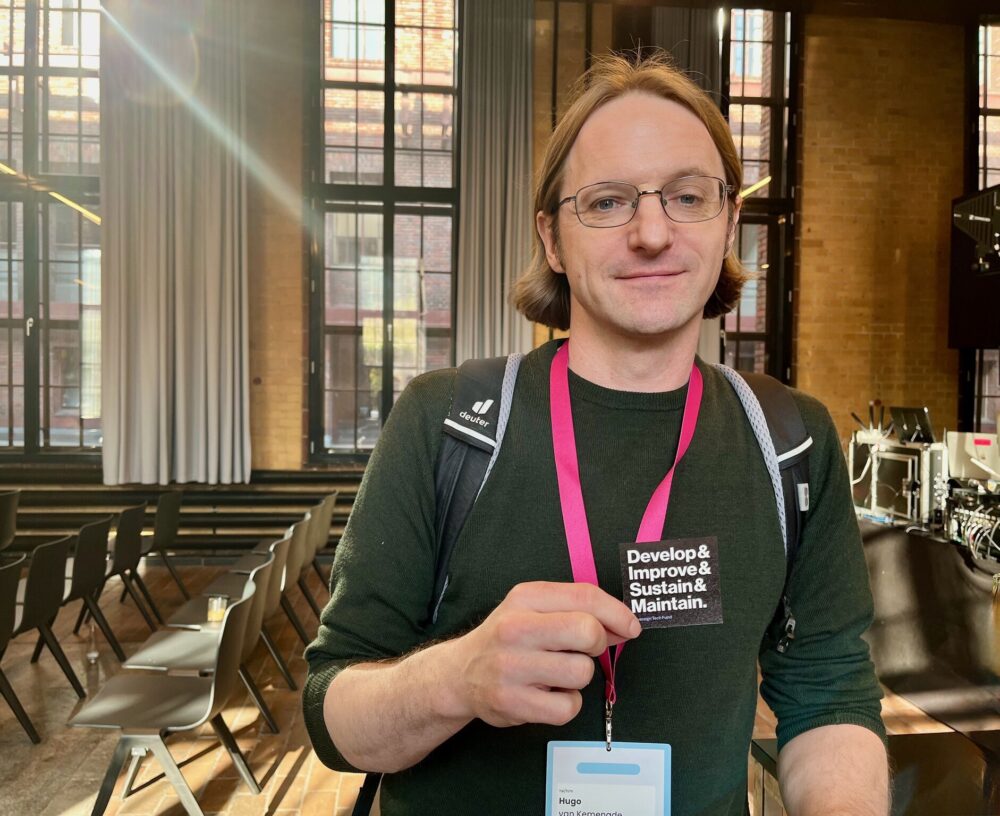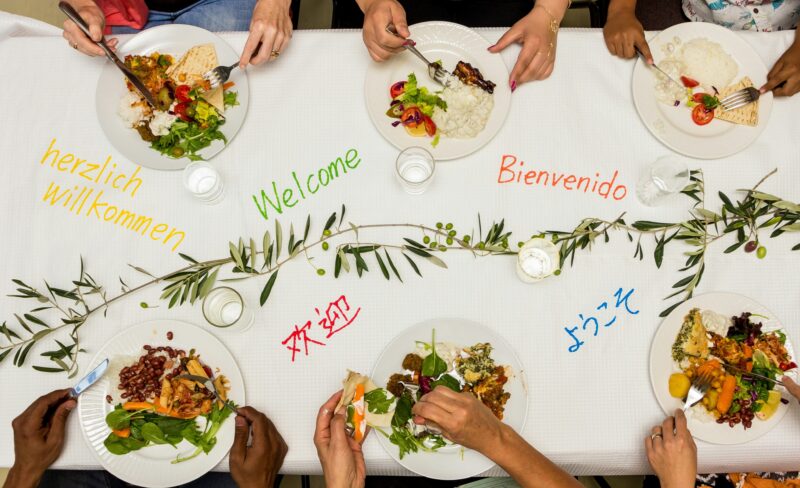
Meet Sovereign Tech Fellow Hugo van Kemenade
By Theresa Röcher
In News, Fellowship
Hugo van Kemenade is a leading voice in the Python community. The projects he maintains are downloaded over 280 million times a month, including libraries used in NASA missions. In this interview, Hugo shows how his passion for contributions has developed into future-proofing the entire Python ecosystem.
Tell us a bit about your background. How did you get involved in open source?
I’ve been involved in open source for about 20 years. I began by creating apps for Nokia Symbian phones in 2005. One of my apps, which allowed users to send SMS messages using Morse code, was even featured on Boing Boing.
In 2008, I began using, and eventually maintaining, an open source project called Mobbler, a Last.fm scrobbler and radio player. Through this project, I developed many of the core skills essential to modern open source work: contributing features, triaging, reviewing patches, planning releases, and engaging with the community.
GitHub made it much easier to discover programs and, more importantly, to contribute back. My first GitHub pull request, submitted in 2012, fixed a Python script used to find duplicate files.
In October 2013, I found a bug in the Python imaging library Pillow. I thought: “it’s open source, I should report it!”. Then I thought: “it’s open source, I could fix it too!” After that, I contributed significantly to Pillow’s test suite and CI infrastructure (Continuous Integration infrastructure). In June 2014, I joined the Pillow team as a maintainer and set out to modernise the codebase by removing unused components and replacing legacy code.
Pillow is a 2010 fork of the Python Imaging Library (PIL), which was originally created in 1995. Over the years, it has become an important tool in fields such as data science, visualization, and artificial intelligence. Due to its widespread adoption, the library now sees approximately 140 million downloads per month.
In 2019, I began sharing responsibility for Pillow’s quarterly releases and looked for ways to streamline and automate the process. The process was pretty manual and slow — I had to build parts of the software, download files by hand, ask someone in California to prepare the Windows version, wait for them to wake up because of the time difference, and then upload everything myself. Today, CI handles the entire process, making releases smoother, more secure, and fully reproducible for all maintainers.
Along the way I took over several abandoned projects in need of maintenance. I standardised and automated their release processes to streamline contributions.
In December 2019, I began contributing to CPython. In January 2022, I joined the triage team and was voted in as a Core Developer shortly after. Last year, I was honoured to be selected as Release Manager for Python 3.14 and 3.15. I focus on ecosystem-wide improvements, such as reviewing top PyPI packages for compatibility with the latest Python version, submitting fixes for deprecations in CPython, and maintaining websites that track the most downloaded packages and those supporting free-threaded Python.
Since January 2022, I’ve served as a Python Enhancement Proposal (PEP) Editor, overseeing the administrative and editorial process for PEPs. I also chair the monthly Documentation Working Group and co-organise Helsinki Python meet-ups. I was honoured with a Google Open Source Peer Bonus in 2020 and named a Python Software Foundation Fellow in 2023 for my contributions to the ecosystem.
Tell us more about the projects you’ll be working on during the fellowship. What makes it important?
I primarily work on CPython, the reference implementation of the Python language.
According to the TIOBE Programming Community index, Python is currently the most popular programming language. Its easy-to-read syntax and versatility make it accessible for beginners, yet powerful enough to scale up to full production systems. Its applications span a wide range of fields, including education, scientific research, full-stack web development, machine learning, AI, and automation, among others.
Python is also deeply embedded in academia, serving both as an introductory programming language and as a key tool in STEM fields and research. For instance, the Event Horizon Telescope team used Python to generate the first-ever image of a black hole, while NASA used Python for ground control, flight modeling, and data processing of the Ingenuity helicopter on Mars. Notably, both projects also used Pillow, a library I maintain.
Beyond CPython and Pillow, I help maintain widely used projects like termcolor, humanize, and PrettyTable, collectively downloaded over 280 million times per month, reflecting their broad adoption and critical role in areas like image processing, deep learning, monitoring, and web development.
I also contribute to data-sharing initiatives like Top PyPI Packages, Python Readiness, and Free-Threaded Wheels, which make important ecosystem information more accessible. For example, Top PyPI Packages publishes monthly data dumps from BigQuery, providing valuable insights that are frequently used in both scientific and industrial research.
What brought you to the Sovereign Tech Fellowship?
I first heard about the Fellowship on the excellent Sustain podcast and it was just what I was looking for! A big challenge with open source is finding time without distractions during evenings and weekends. Being able to dedicate time on projects allows me to take on larger chunks of work and to be available to help others.
As the release manager for Python 3.14 and 3.15, my role involves regularly publishing new versions at each stage of the software lifecycle. Being more available during releases allows for quicker responses to issues and enables greater focus on improving release automation, benefiting both myself and other release managers.
With more time dedicated to supporting contributors, I work on documentation and process improvements. I have scripts to help me with triage, and have turned them into dashboards to assist triagers, helping uncover bugs and security fixes that had already been resolved but not yet backported to older versions.
Similar efforts extend to non-CPython projects, where the focus remains on bug and security fixes, automation, faster triage, and building long-term sustainability.
I can also spend more time mentoring and on community work, such as chairing Documentation Workgroup meetings to enable the community to get involved, and helping the new User Success Workgroup get up and running.
I blog and post to social media to let people know what’s going on in core development and things like how the community can help test pre-releases and new experimental features.
What makes open source collaboration special and what do you enjoy most about it?
It's good when you find a bug to not just report it, but also fix it, to help everyone else who uses it. It's rewarding to know people use the software I work on and hear some of the amazing things they create with it. Open source is as much about people as software, and I've made a lot of new friends. Most open source work is asynchronous via issue trackers or via chat platforms, and occasionally via video meetings, but it's great to meet people in person at conferences and sprints.
What do you do when you’re not working on open source?
I enjoy cycling and commute by bike all year round in Helsinki. During lockdown, I started "collecting" map tiles: OpenStreetMap map tiles at a certain zoom level are about 1km across, and the idea is to visit as many as possible.
This is clearly an endless task which only gets harder, but luckily I like looking at maps, cycling and discovering new places! This benefits from the freedom to roam the countryside in Finland ("jokaisenoikeus"), and I occasionally end up carrying a bike through the forest or swamp, or waiting until winter to cycle across the sea to islands to collect just one more tile. So far I have collected 2,925 tiles, with the biggest square 28x28.
Connect with Hugo
We’re grateful to Hugo for being part of the first cohort of the Sovereign Tech Fellowship and for his continued contributions to the FOSS ecosystem. If you're interested in Hugo's work, you can check out his very own announcement blog post.

Hugo at FOSS Backstage in March 2025
You can find Hugo at hugovk.dev and on GitHub, Mastodon, Bluesky and LinkedIn.


